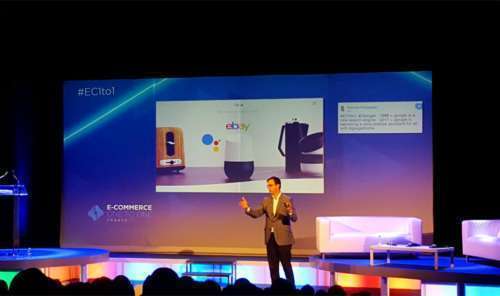How voice & AI will transform retail & e-commerce

Source: Lsa-conso.fr – Guillaume Bacuvier, VP Advertising Solutions, EMEA at Google
In 2015, e-Commerce One To One Monaco showcased the insights of Guillaume Bacuvier, VP of Advertising Solutions, EMEA at Google. During the keynote presented by Ingrid Fillon, he discussed the technological shifts set to influence Google Search, Retail, and eCommerce in the foreseeable future, primarily due to innovations like voice and AI.
Google’s Home Assistant is perceived as the web browser of tomorrow. This groundbreaking technology behaves much like a human personal assistant responding to voice commands. The dominant Search Engine is propelled to brainstorm inventive approaches for heightened personalization and improving the user’s life, resembling what an assistant would offer. Tasks become simpler and quicker. The reliance on traditional devices like computers or mobiles diminishes, promoting a seamless Google experience. Both business professionals and millennials are welcoming this robot assistant era.
2017 X YouTube video – Voice Commerce, two case studies for Nespresso & L’Oréal
The ascent of AI personal assistants in e-commerce and retail
Vincent Ducrey of the Hub Institute, in a webinar on the subject, highlighted technological milestones connecting Humanity and Machines:
1960: Keyboard => Machine translates human thoughts into structured messages.
1968: Mouse => Machine deciphers human intentions through mouse movements.
2007: Fingerprints => Machine identifies humans through unique sensory prints.
2015: Gesture => Machine detects human movements and associates them with identities.
Progressively, each innovation has enhanced personalized assistance. While initially, the Machine’s primary goal was mere message delivery, it now engages more intelligently with humans. Technologies like fingerprint recognition and gesture detection underscore this evolution. Presently, the harmonization of voice and AI stands out. Apple set the stage with “Siri” in 2010, initially available on iPhones and Tablets. Siri marked the onset of a grander vision, providing assistance in day-to-day life by offering real-time details like weather, stock updates, and more.
2017 X YouTube video – X with Natural Language Classifier (NLC)
The influence of voice and AI on e-commerce and retail’s future
Additionally, this software can execute tasks such as sending messages or making calls based on voice commands. However, tech titans like Microsoft (with Cortana), Amazon (with Alexa), and IBM (with IBM Watson) soon launched their personal assistant solutions, aligning with partners like X.
Today, numerous devices incorporate features like home control assistants, video game integrations, or car assistance. But what’s the e-Commerce angle? 66% of individuals express interest in voice assistants, either yet to use them or already adopting them regularly. Gartner predicts that sales via voice assistants could surpass €2.1 billion.
Predictive analytics and AI: personalization’s future frontier
X, in collaboration with IBM Watson, has devised its AI to introduce a 1:1 marketing tool enhancing the consumer journey. Interoperable across multiple sectors, this tool aligns seamlessly with Google’s vision. Essentially, X’s solution is designed to simplify consumers’ lives and meet their needs more precisely.
This forward-thinking startup in predictive analytics offers immense value to e-commerce businesses. According to Google, consumer queries will become more direct and immediate. In an increasingly interconnected world, individuals prioritize immediacy, often valuing availability over quality or cost. Additionally, there’s a growing appetite for unique and immersive experiences. While once crucial for luxury brands, today’s consumer seeks a sense of pampering and connection with brands.
2017 X YouTube video – SkinCeuticals: Shopping Assistant Prototype v1
X harnesses AI and predictive analytics to deliver these experiences. The front-end enables users to voice requests, fostering a bond between consumer and machine. Meanwhile, the back-end leverages extensive web data analysis to chart user preferences and behavior. For instance, with Nespresso, X anticipates the type of pods a user might prefer based on their character and actions. For L’Oréal, AI reconstructs consumer profiles to provide targeted product suggestions and relevant content.
Explore more about X to understand how we can elevate your results!



